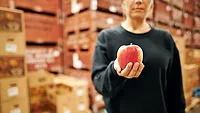Chemometrics in Food Safety: A Data-Driven Approach to Protecting Consumers
The application of statistical and mathematical methods to chemical data has revolutionized food safety analysis

Image credit: andreswd/E+ via Getty Images
Food safety is a major global concern, with millions of people affected by foodborne illnesses each year. According to the World Health Organization (WHO), unsafe food is responsible for over 600 million cases of foodborne illness annually, placing a substantial burden on public health systems and economic productivity.1 However, traditional methods for ensuring food safety are often time-consuming and expensive, necessitating the development of more advanced techniques.
Chemometrics, which involves the application of statistical and mathematical methods to chemical data, has revolutionized food safety analysis. By integrating chemometric techniques with spectroscopy, chromatography, and artificial intelligence (AI), researchers and industry professionals can rapidly detect contaminants, verify food authenticity, and predict shelf life with high accuracy. This article explores the applications of chemometrics in food safety, including contamination detection, fraud prevention, quality assessment, and regulatory compliance. Additionally, emerging technologies such as blockchain and the Internet of Things (IoT) are enhancing the traceability and efficiency of chemometric approaches.
As the food industry continues to evolve, chemometrics will remain a vital tool for ensuring consumer safety and product integrity.
Integrating Chemometrics Into Food Safety
Food safety is a critical global concern, as contamination in food can lead to severe health issues and economic losses. With the increasing globalization of food trade, the complexity of supply chains has made it difficult to track and prevent contamination, fraud, and quality degradation. These challenges have underscored the urgent need for more sophisticated analytical tools to monitor food safety efficiently.2 Chemometrics, a branch of science that applies mathematical and statistical methods to chemical data, has emerged as a key solution in addressing these challenges.3 By utilizing techniques such as multivariate analysis, pattern recognition, and machine learning, chemometrics enables precise identification of contaminants, verification of food authenticity, and assessment of overall product quality.4
The integration of chemometric techniques with modern analytical tools, such as spectroscopy and chromatography, has revolutionized food safety testing by providing rapid, cost-effective, and highly accurate results. These innovations have made it possible to detect even trace amounts of harmful substances such as pesticides, heavy metals, and mycotoxins, preventing them from reaching consumers.5
Beyond contamination detection, chemometrics plays a crucial role in predictive analytics, helping manufacturers forecast shelf life, optimize storage conditions, and improve food processing techniques. With the advent of AI and blockchain technology, chemometrics is becoming an even more powerful tool for ensuring transparency and traceability in the food industry. By leveraging data-driven approaches, chemometric applications continue to evolve, offering solutions that not only enhance food safety but also support regulatory compliance and consumer trust in the marketplace.5
Detection of Food Contaminants
Food contamination, whether intentional or accidental, poses serious risks.6 Spectroscopic techniques such as near-infrared (NIR), Fourier-transform infrared (FTIR), and Raman spectroscopy, coupled with chemometric models, provide rapid and nondestructive detection methods.4,7 For example, principal component analysis (PCA) and partial least squares regression (PLSR) are widely used to classify and quantify contaminants in food samples.4 These techniques allow scientists to detect harmful substances at extremely low concentrations, improving food safety monitoring at every stage of production.
Looking for quick answers on food safety topics?
Try Ask FSM, our new smart AI search tool.
Ask FSM →
Furthermore, integrating sensor technologies with chemometric models has enabled the development of portable devices that provide real-time analysis, reducing dependence on laboratory-based testing and enabling quicker responses to contamination events.5
Combating Food Fraud and Adulteration
Food fraud, including mislabeling and adulteration, is a growing issue worldwide. Chemometrics plays a vital role in ensuring food authenticity by interpreting spectral and chromatographic data. Techniques like hierarchical cluster analysis (HCA) and linear discriminant analysis (LDA) have been successfully applied to distinguish between genuine and counterfeit food products.8 For example, chemometric methods have been used to differentiate pure honey from adulterated versions containing sugar syrups.9 In the wine industry, chemometric approaches have been used to classify wines based on their geographical origin, ensuring that consumers receive authentic products while helping authorities combat fraudulent labeling. These methods also extend to dairy products, meat, and spices, where detection of dilution and substitution practices ensures transparency in food supply chains.10
Food Quality Assessment and Shelf Life Prediction
Chemometric approaches also contribute to food quality assessment and shelf life prediction. Predictive models help manufacturers optimize storage conditions and packaging to maintain food quality.11,12 Multivariate statistical analysis is often used to assess the deterioration of food products over time by monitoring changes in chemical composition. For example, in dairy products, chemometrics is used to evaluate the freshness of milk by analyzing volatile organic compounds.13 In the meat industry, spectral analysis combined with chemometric modeling can help assess tenderness, color stability, and microbial contamination, ensuring product quality throughout storage and distribution.
The use of these predictive models minimizes food waste by accurately estimating expiration dates based on real-time compositional changes rather than fixed dates, benefiting both consumers and retailers.13
Integration of AI in Chemometrics
With advancements in AI and machine learning, chemometrics is evolving rapidly. Integrating deep learning algorithms with chemometric techniques can further enhance food safety assessments.14 Neural networks and support vector machines are increasingly being used to improve the accuracy of classification models, allowing faster and more precise detection of contaminants. Additionally, machine learning methods can automate the interpretation of large datasets, reducing human error and improving decision-making in food safety management.15
However, challenges such as data standardization, model validation, and regulatory acceptance must be addressed for widespread implementation. The harmonization of chemometric methods across different regions and industries is essential to facilitate global trade and ensure consistent food safety standards.
Blockchain Technology for Food Traceability
One of the most promising developments in chemometrics is the integration of blockchain technology to improve traceability in the food supply chain. Blockchain, combined with chemometric techniques, enables real-time tracking of food products from farm to consumer, ensuring transparency and reducing the risk of food fraud. By linking analytical data with blockchain records, food safety agencies and consumers can verify the authenticity and safety of food products. This approach has been particularly effective in monitoring the organic food market, where cases of false labeling are prevalent.
IoT Applications in Food Safety
Another emerging application of chemometrics in food safety is the use of IoT devices in food storage and transportation. IoT sensors can continuously monitor environmental conditions such as temperature, humidity, and gas composition, while chemometric models analyze this data to predict potential risks. For instance, in seafood logistics, IoT-based chemometric solutions help ensure optimal storage conditions and detect early signs of spoilage, reducing losses and maintaining food quality during transit.16,17
Chemometrics in Food Safety Regulations
In addition to industry applications, chemometric techniques are becoming increasingly valuable in food safety policy and regulation. Governments and regulatory bodies use chemometric-based risk assessment models to identify potential hazards in food products before they reach the market. By analyzing historical contamination patterns, these models can predict future risks, allowing for proactive measures to prevent foodborne illnesses. Regulatory agencies are also investing in advanced chemometric tools to enhance food inspection protocols, ensuring compliance with stringent safety standards.18
Future Trends in Chemometrics for Food Safety
Looking ahead, the future of chemometrics in food safety is likely to be shaped by advancements in quantum computing. Quantum algorithms have the potential to process massive datasets at unusual speeds, allowing for real-time identification of contaminants and food adulteration with unparalleled accuracy.
Moreover, the integration of augmented reality (AR) with chemometric techniques is opening new avenues in food quality assessment. AR-based chemometric applications could provide instant visual feedback on food composition and safety parameters, empowering consumers to make informed purchasing decisions.
Takeaway
Chemometrics provides powerful tools for ensuring food safety by offering rapid, accurate, and cost-effective analytical solutions. The adoption of chemometric techniques in routine analysis will continue to grow as food safety regulations become increasingly stringent, protecting consumers from potential risks and ensuring the integrity of the global food supply chain.
The future of chemometrics in food safety looks promising, with emerging technologies such as quantum computing and blockchain integration further enhancing traceability and analytical precision.
References
- World Health Organization (WHO). "Food Safety." 2025. https://www.who.int/health-topics/food-safety#tab=tab_1.
- Ellahi, R.M., L.C. Wood, and A. E.-D. A. Bekhit. "Blockchain-Driven Food Supply Chains: A Systematic Review for Unexplored Opportunities." Applied Sciences 14, no. 19 (2024): 8944. https://www.mdpi.com/2076-3417/14/19/8944.
- Peris-Díaz, M.D. and A. Krężel. "A Guide to Good Practice in Chemometric Methods for Vibrational Spectroscopy, Electrochemistry, and Hyphenated Mass Spectrometry." TrAC Trends in Analytical Chemistry 135 (2021): 116157. https://www.sciencedirect.com/science/article/pii/S0165993620303861.
- Kaushal, S., P. Nayi, D. Rahadian, and H.-H. Chen. "Applications of Electronic Nose Coupled with Statistical and Intelligent Pattern Recognition Techniques for Monitoring Tea Quality: A Review." Agriculture 12, no. 9 (2022): 1359. https://www.mdpi.com/2077-0472/12/9/1359.
- Ziani, I., H. Bouakline, A. El Guerraf, A. El Bachiri, M.-L. Fauconnier, and F. Sher. "Integrating AI and Advanced Spectroscopic Techniques for Precision Food Safety and Quality Control." Trends in Food Science & Technology (2024): 104850. https://www.sciencedirect.com/science/article/pii/S0924224424005260.
- Poltronieri, P. "Innovations in Detection of Deliberate or Accidental Contamination with Biological Agents in Environment and Foods." Challenges 7 (2016): 22. https://www.mdpi.com/2078-1547/7/2/22.
- Cebi, N., H. Bekiroglu, and A. Erarslan. "Nondestructive Metabolomic Fingerprinting: FTIR, NIR and Raman Spectroscopy in Food Screening." Molecules, 28, no. 23 (2023): 7933. https://www.mdpi.com/1420-3049/28/23/7933.
- Rodionova, O.Y., P. Oliveri, C. Malegori, and A.L. Pomerantsev. "Chemometrics as an Efficient Tool for Food Authentication: Golden Pillars for Building Reliable Models." Trends in Food Science & Technology (2024): 104429. https://www.sciencedirect.com/science/article/pii/S0924224424001055.
- Başar, B. "Development of Fast and Simple Analytical Methods for the Determination of Honey Adulteration and Forgery Based on Chemometric Multivariate Data Analysis by Using Molecular Spectroscopy." Unpublished master's thesis. Izmir Institute of Technology (2016).
- Brescia, M.A., I.J. Košir, V. Caldarola, J. Kidrič, and A. Sacco. "Chemometric Classification of Apulian and Slovenian Wines Using 1H NMR and ICP-OES Together with HPICE Data." Journal of Agricultural and Food Chemistry 51, no. 1 (2003): 21–26. https://pubmed.ncbi.nlm.nih.gov/12502380/.
- Martin-Torres, S., L. Ruiz-Castro, A.M. Jimenez-Carvelo, and L. Cuadros-Rodriguez. "Applications of Multivariate Data Analysis in Shelf Life Studies of Edible Vegetal Oils—A Review of the Few Past Years." Food Packaging and Shelf Life 31 (2022): 100790. https://www.sciencedirect.com/science/article/abs/pii/S2214289421001587.
- Pedro, A.M. and M.M. Ferreira. "The Use of Near-Infrared Spectroscopy and Chemometrics for Determining the Shelf-Life of Products." Applied Spectroscopy 63, no. 11 (2009): 1308–1314. https://pubmed.ncbi.nlm.nih.gov/19891841/.
- Aleixandre-Tudó, J.L., L. Castelló-Cogollos, J.L. Aleixandre, and R. Aleixandre-Benavent. "Chemometrics in Food Science and Technology: A Bibliometric Study." Chemometrics and Intelligent Laboratory Systems 222 (2022): 104514. https://www.sciencedirect.com/science/article/pii/S0169743922000259.
- Lin, Y., J. Ma, Q. Wang, and D.-W. Sun. "Applications of Machine Learning Techniques for Enhancing Nondestructive Food Quality and Safety Detection." Critical Reviews in Food Science and Nutrition 63, no. 12 (2023): 1649–1669. https://pubmed.ncbi.nlm.nih.gov/36222697/.
- Kuppusamy, S., M. Meivelu, L. Praburaman, M.M. Alam, and A.G. Al-Sehemi. "Integrating AI in Food Contaminant Analysis: Enhancing Quality and Environmental Protection." Journal of Hazardous Materials Advances 16 (2024): 100509. https://www.sciencedirect.com/science/article/pii/S2772416624001104.
- Wang, D., M. Zhang, Q. Jiang, and A.S. Mujumdar. "Intelligent System/Equipment for Quality Deterioration Detection of Fresh Food: Recent Advances and Application." Foods 13, no. 11 (2024): 1662. https://pubmed.ncbi.nlm.nih.gov/38890891/.
- Witjaksono, G., A.A. Saeed Rabih, N.B. Yahya, and S. Alva. "IOT for Agriculture: Food Quality and Safety." IOP Conference Series: Materials Science and Engineering 343 (2018). https://iopscience.iop.org/article/10.1088/1757-899X/343/1/012023.
- Bona, E., P.H. Março, and P. Valderrama. "Chapter 4: Chemometrics Applied to Food Control." In Food Control and Biosecurity: Handbook of Food Bioengineering. Elsevier, 2018. https://www.sciencedirect.com/science/article/abs/pii/B9780128114452000040.
Sushant Kaushal is a Ph.D. candidate in the Department of Tropical Agriculture and International Cooperation at the National Pingtung University of Science and Technology in Pingtung, Taiwan.
Priya Rana, Ph.D., is affiliated with the Department of Food Science at National Pingtung University of Science and Technology.
Ho-Hsien Chen, Ph.D., is a Professor in the Department of Food Science at the National Pingtung University of Science and Technology.








